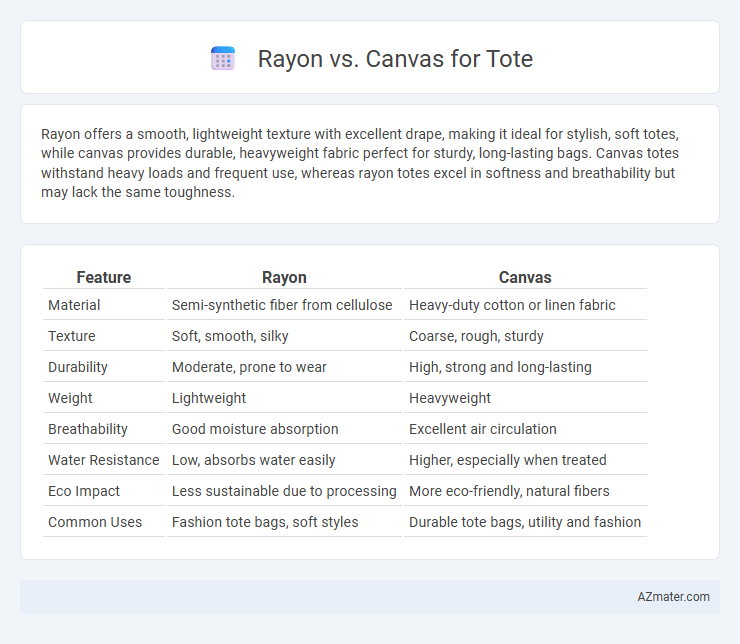Rayon offers a smooth, lightweight texture with excellent drape, making it ideal for stylish, soft totes, while canvas provides durable, heavyweight fabric perfect for sturdy, long-lasting bags. Canvas totes withstand heavy loads and frequent use, whereas rayon totes excel in softness and breathability but may lack the same toughness.
Table of Comparison
| Feature | Rayon | Canvas |
|---|---|---|
| Material | Semi-synthetic fiber from cellulose | Heavy-duty cotton or linen fabric |
| Texture | Soft, smooth, silky | Coarse, rough, sturdy |
| Durability | Moderate, prone to wear | High, strong and long-lasting |
| Weight | Lightweight | Heavyweight |
| Breathability | Good moisture absorption | Excellent air circulation |
| Water Resistance | Low, absorbs water easily | Higher, especially when treated |
| Eco Impact | Less sustainable due to processing | More eco-friendly, natural fibers |
| Common Uses | Fashion tote bags, soft styles | Durable tote bags, utility and fashion |
Introduction to Tote Bag Materials
Rayon and canvas are popular materials for tote bags, each offering distinct characteristics suited to different uses. Rayon, a semi-synthetic fiber derived from cellulose, provides a smooth, lightweight, and soft texture that enhances the bag's aesthetic appeal and comfort. Canvas, a durable and heavy-duty fabric typically made from cotton or linen, ensures high strength and long-lasting performance, making it ideal for carrying heavier items and daily use.
What is Rayon?
Rayon is a semi-synthetic fiber made from regenerated cellulose derived from wood pulp, known for its silk-like feel and smooth texture. It is highly absorbent, breathable, and drapes well, making it a popular choice for lightweight, soft tote bags that offer comfort and style. Compared to canvas, rayon totes are less durable but provide a more luxurious and flexible fabric option ideal for casual use.
What is Canvas?
Canvas is a durable, heavy-duty fabric made primarily from cotton or linen, known for its sturdy weave and resistance to wear and tear. It offers excellent strength and is often chosen for tote bags due to its ability to hold shape and withstand heavy loads. Unlike rayon, canvas provides superior durability and longevity, making it ideal for everyday use and outdoor activities.
Durability: Rayon vs Canvas
Canvas offers superior durability compared to rayon due to its tightly woven, heavy-duty cotton fibers that resist wear and tear over time. Rayon, being a semi-synthetic fiber derived from cellulose, tends to be less sturdy and more prone to stretching, shrinking, and abrasion under heavy use. For totes requiring long-term resilience and heavy load support, canvas remains the optimal choice.
Weight and Texture Comparison
Rayon offers a lightweight and smooth texture ideal for tote bags requiring softness and drape, while canvas provides a heavier and sturdier fabric with a coarse, durable feel suited for robust use. Tote bags made from canvas typically weigh more, enhancing strength and longevity, whereas rayon totes are lighter and more flexible, favoring casual or fashion-focused designs. The choice between rayon and canvas depends largely on the desired balance between durability and comfort in tote bag construction.
Eco-Friendliness and Sustainability
Rayon is a semi-synthetic fiber derived from cellulose, often sourced from wood pulp, making it biodegradable but associated with intensive chemical processing that can harm the environment. Canvas, typically made from organic cotton or hemp, offers greater sustainability due to minimal chemical treatments and the use of renewable resources, supporting eco-friendly production practices. Choosing canvas tote bags reduces carbon footprint and pollution compared to rayon, aligning better with sustainable fashion and zero-waste principles.
Cost Differences
Rayon tote bags generally cost more than canvas due to the manufacturing complexity and the finer, softer texture of rayon fibers. Canvas, made from cotton or linen, is more affordable because of its widespread availability and simpler production process. The price gap often reflects the durability and aesthetic differences, with canvas offering a budget-friendly, sturdy option and rayon appealing to higher-end markets.
Care and Maintenance Tips
Rayon tote bags require gentle hand washing with cold water to prevent shrinking and fabric damage, while canvas totes are more durable and can usually withstand machine washing with mild detergent. Avoid using bleach or harsh chemicals on both materials to maintain color vibrancy and fabric integrity. Air drying is recommended for rayon to prevent deformation, whereas canvas totes can often be tumble-dried on low heat without significant wear.
Best Uses for Rayon Totes
Rayon totes offer a lightweight and smooth texture ideal for stylish, everyday use such as casual shopping or carrying light personal items. Their silky finish and vibrant dye absorption make them perfect for promotional events and fashion-forward tote designs requiring eye-catching aesthetics. Unlike canvas, rayon is less durable but excels in softness and drape, making it best suited for tote bags intended for light-duty, fashionable purposes rather than heavy or rugged use.
Best Uses for Canvas Totes
Canvas totes offer exceptional durability and water resistance, making them ideal for heavy-duty use such as grocery shopping and carrying bulky items. Unlike rayon, which is softer and more prone to wear, canvas maintains its shape and withstands frequent washing and rough handling. Its natural fiber composition also ensures breathability and sustainability, making canvas totes a preferred choice for eco-conscious consumers seeking long-lasting, everyday bags.

Infographic: Rayon vs Canvas for Tote
 azmater.com
azmater.com